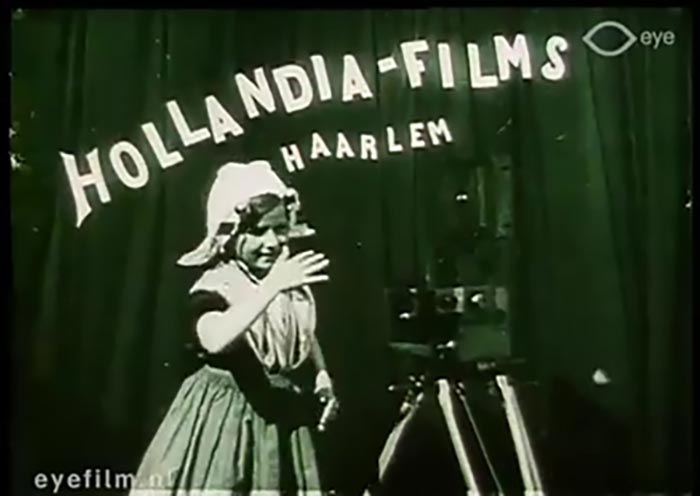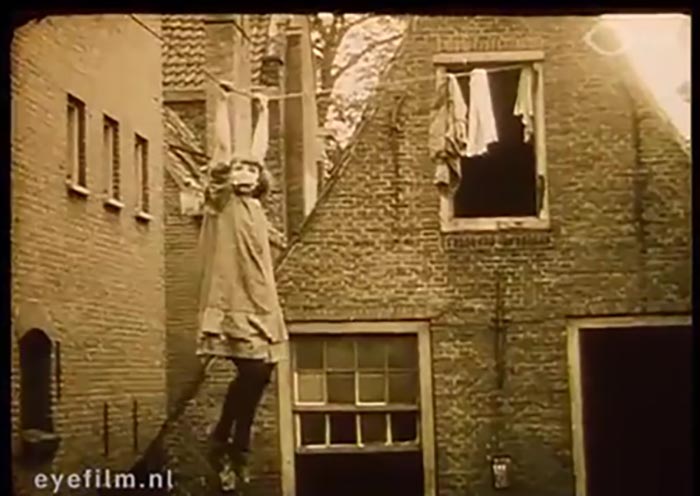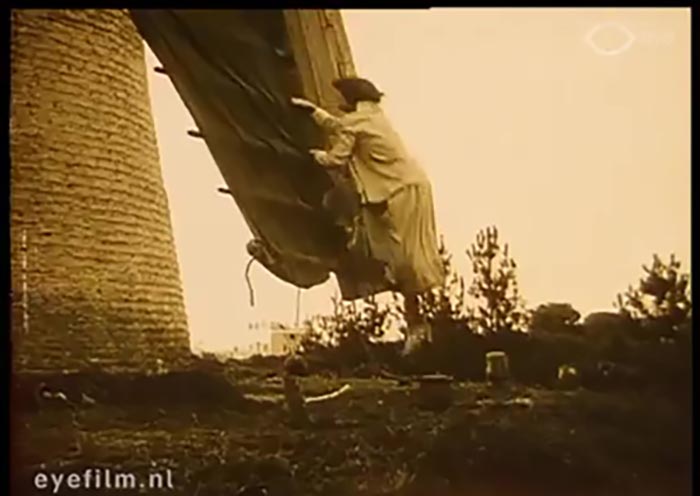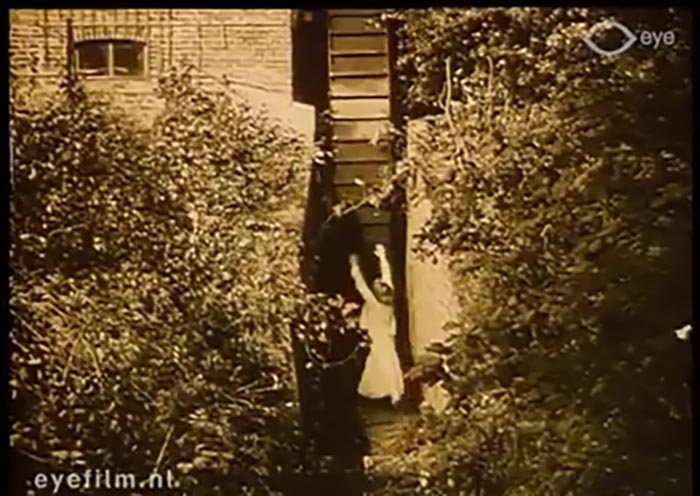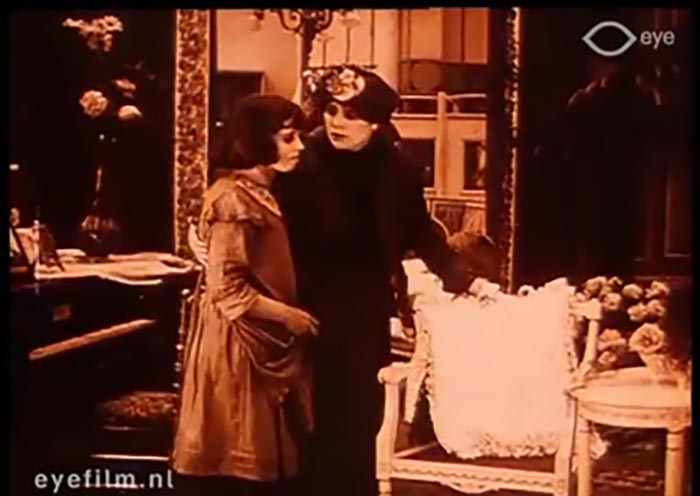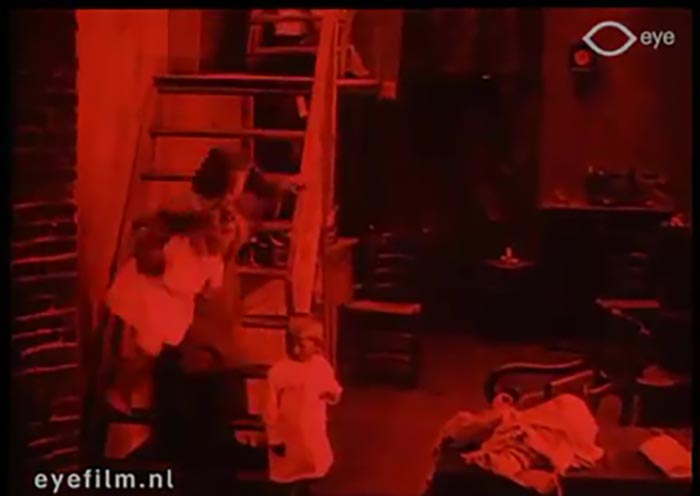The Netherlands plays around with the popular crime drama in this feature and they do it up big, incorporating Delft porcelain glaze and windmills. It’s a chance to see Dutch star Annie Bos in action.
Home Media Availability: Watch on EYE’s YouTube channel.
The Tin Glaze Conspiracy
The Dutch film industry was not as big as those of its neighbors but it had its own studios, stars and style. The Hollandia film company was founded in 1913 by Marits H. Binger and The Encyclopedia of Early Cinema describes typical Dutch settings and landmarks as the house style for Hollandia, at least in the beginning. I mean, if the studio logo is a little girl in traditional clothing throwing flower petals, I guess we can call that accurate advertising.
The Secret of the Delft further leaned into the “We’re Dutch, dammit!” theme with a plot centering on the distinct tin glaze. Delftware’s heyday was in the seventeenth and eighteenth centuries and pieces from this era are considered to be the finest and most collectible. They’re lovely things, clean blue and white with scenes of outdoors, romance and, of course, flowers.
The Secret of Delft centers on a return to the glory days of Delftware. Jan Vogel (Jan van Dommelen) works at a ceramics factory and dreams of reviving Delft glaze but he needs money to continue his experiments. His older daughter, Annie (Annie Bos), is a piano tutor to his boss’s daughter and the boss’s son, Leo van Haaften (Frederick Vogeding), has a non-musical interest.
Meanwhile, the nefarious Willem Berg (Willem van der Veer) wants not only to steal the secret Delftware formula once it is discovered, he wants to steal Annie’s heart as well! Things get worse. When the romance between Annie and Leo is discovered, all parents deny their blessing and Leo is like “Nothing I can do, darling. Sorry. Stinks, huh?”
And then, just when Vogel discovers the Delftware secret, he framed for the murder of Leo’s father. Leo, once again, proves himself to be immensely helpful and tells Annie there’s nothing he can do about their romance until her father clears his name.
Will Willem succeed in his nefarious plan? Well, he didn’t count on Lilly (Lily Bouwmeester), the younger daughter of the Vogel family. Now, every other Vogel in the picture is talented but not exactly savvy. Well, Lilly more than makes up for it, evading Willem, burning the formula after memorizing it, gathering evidence to clear her father’s name and generally making Nancy Drew look like a rank amateur.
The Secret of Delft is worth viewing because it’s a chance to see two generations of top Dutch actresses at the same time. Annie Bos was the queen of the Dutch cinema and, while her character has terrible taste in men, she more than makes up for it during the climactic chase scene in which she evades Willem by riding up a waterwheel and then grabbing onto the sails of a windmill. Told you this was Dutch.
Lily Bouwmeester was fifteen but looked at least six years younger and she completely stole the show as Lilly. Her evident charisma served her well in the 1930s when she made a triumphant comeback to the screen and became one of the most popular actresses of pre-WWII Dutch cinema, with Anne Frank among her fans. Bouwmeester was part of a long line of stage actors, though her father was the black sheep and became a violinist, so she came by her talent honestly.
During the Nazi occupation of the Netherlands, Bouwmeester refused to act because she was concerned that her appearance would be used for propaganda. She quit the movies and could not be enticed to return even when the war ended, preferring retirement in the Hague.
(The Bouwmeester family is listed in the Encyclopaedia Judaica but it seems that Bouwmeester’s star power was a protection to her. This was the exception. Other Jewish silent era stars, like German leading lady Thea Sandten, were murdered in concentration camps. Others, like Austrian Friedrich Feher and Polish actress Wanda Treumann, had to flee. This list is a tiny sample that barely scratches the surface.)
So, how about those windmills?
Cultural cliches and stereotypes onscreen are a complicated subject. After all, every nation and culture is more than the sum of their cliches. Americans don’t dash around the place demanding ice for their drinks constantly (we have ice dispensers everywhere anyway). Not every Parisian lives under the Eiffel Tower.
However, I would be lying if I said there wasn’t charm in The Secret of Delft’s utter embrace of a tourist version of the Netherlands. Using one of their most famous exports and one of their most famous agricultural features is pretty darn appealing, I must say. Dutch stereotypes were rampant in Hollywood productions but the rules are a bit different when people are playing with their own cliches.
With the talent and physical prowess of both leading ladies, the utter indulgence of non-Dutch viewers and its oh-so-pulpy plot, this is a pretty fun night at the movies. It’s a short feature, about five reels or just over an hour, but it’s jam-packed with fun and adventure and thrills and melodrama.
Melodrama is a somewhat complicated topic when discussing silent film. After all, the mustachioed villain attacking a screaming maiden is the image that appears before John Q. Public when silents are brought up. Not all silents were melodramas. In fact, most were not. However, there certainly were popular melodramas that allowed audiences to cheer the heroines and boo the villains.
And that damsel in distress? Well, in this case, the ladies have the villainous Willem thoroughly outfoxed. Lilly in particular acts as the action hero, emerging from a burning building with one toddler sibling under each arm and the memorized Delftware formula in her head. I’ll wager that’s not what most people expect from a silent movie but it was a remarkably common sight.
The trick with melodrama is to just relax and get into the spirit of the thing. Cheer for Lilly! Boo Willen! Applaud when a particularly bold rescue is undertaken! Gasp at the windmill scene! (It is spectacular.) Silent era audiences knew this was exaggerated but they also knew that they were having fun and I think the fun translates to modern times. All we need is an open mind and, perhaps, a willingness to hiss at the screen when the villain shows up.
I thoroughly enjoyed The Secret of Delft. It showcased its heroines well, the action is exciting and it looks amazing, thanks to the beautiful tinted print. (Do watch when the characters open and close the kiln door. The tinting changes to create the illusion of a blazing fire inside.) The only weak point is the rather placid and uninteresting Leo as the leading man but I suppose we can’t have everything.
Where can I see it?
The EYE Film Museum released this film on their YouTube channel. There are optional English subtitles, so be sure to turn them on if you don’t speak Dutch and if you do, hoi there, nice film museum you have!
☙❦❧
Like what you’re reading? Please consider sponsoring me on Patreon. All patrons will get early previews of upcoming features, exclusive polls and other goodies.
Disclosure: Some links included in this post may be affiliate links to products sold by Amazon and as an Amazon Associate I earn from qualifying purchases.

